Eastern Europe has been hit hard by inflation in the last year and a half, primarily due to the ongoing Russian invasion of Ukraine that began in February 2022. Since the start of the war, Europe as a whole has seen inflation rates hit double-digits, but the continent has been struggling to regain its economic footing since the COVID-19 pandemic.
In 2020, Eastern Europe’s response to the pandemic was a loosening of monetary policies to support citizens and protect against short-term economic loss, which ultimately led to higher inflation and an increased cost of living. Out of the whole continent, Eastern Europe has been impacted the most; while it used to be known for countries with lower living costs compared to the rest of Europe, the cost of living in Eastern Europe is now almost comparable to Western European countries.
After the Russian invasion of Ukraine, Eastern Europe saw a sharp decrease in retail sales, skyrocketing food and energy prices and higher rent, all of which have cut significantly into families’ incomes. Hungary, a small, landlocked country bordering Ukraine and the EU country with the highest rate of inflation, saw the most severe inflation rates it has seen in decades following the invasion, rising more than 20% year after year from January 2021 to December 2022.
How is this crisis impacting the average Eastern European citizen?
Low-income families are paying around double for groceries, electricity and gas compared to upper-middle and wealthy families in Eastern Europe. This results in worse economic gaps between low and high-earning families. Food prices have also risen faster in Hungary than any other country in the EU, rising over 45% from 2022 to 2023, with Slovakia in second place at 29%.
Meat products, once considered a staple in the Eastern European diet, are now a luxury for many. Bottled water, milk, eggs and bread now cost 72-80% more than they did in 2021– a staggering difference when compared to the average monthly income of Hungarians, which is 554,540 forints (about $1,631 USD). A dozen eggs can now cost as much as 858 forints (about $2.34 USD); this is not currently a sustainable price point for the average Hungarian. In Hungary, many families like to vacation in Lake Balaton, a world-famous vacation destination that European citizens flock to every summer for its warm temperatures and beautiful landscapes.
When I visited Hungary this July, I was shocked by the cost of food. Cheese was somehow more expensive in Hungary than in the United States and what I would have considered affordable in Hungary the last time I was there was no longer affordable. According to my Hungarian family members, as well as other Hungarians I met during my time there, fewer and fewer people are able to travel for vacation to other countries or even within Hungary.
The risks of inflation rates remaining this high are many, including consumers buying fewer things, having to find a second or third job, finding alternatives to using gas and having less disposable income, which in turn negatively impacts Eastern Europe’s economies. According to the European Commission, Hungary’s GDP growth fell from 4.6% in 2022 to a mere 0.5% in 2023, and unemployment rose from 3.6% in 2022 to 4.2% in 2023. Experts predict that Hungary will be able to recover in 2024 with forecasted disinflation and a tightening of monetary policy. Hungarians should expect a decrease in inflation to 7-8% by December of this year, according to Hungary’s Finance Minister Vargás. The IMF predicts a low 0.3% GDP growth in Poland for 2023, 2.4% in Romania and -0.3% in Lithuania.
The Israel-Palestine war will affect not only the Middle East’s economy but Eastern Europe’s as well; the cost of oil has already risen but will expect to recover unless Iran is sanctioned by the West for its support of Hamas. With no end in sight for the Russia-Ukraine war, rippling global conflict, lower consumption and economic activity and climate disasters such as wildfires and heat waves, the next couple of years will be difficult for Eastern Europeans.







